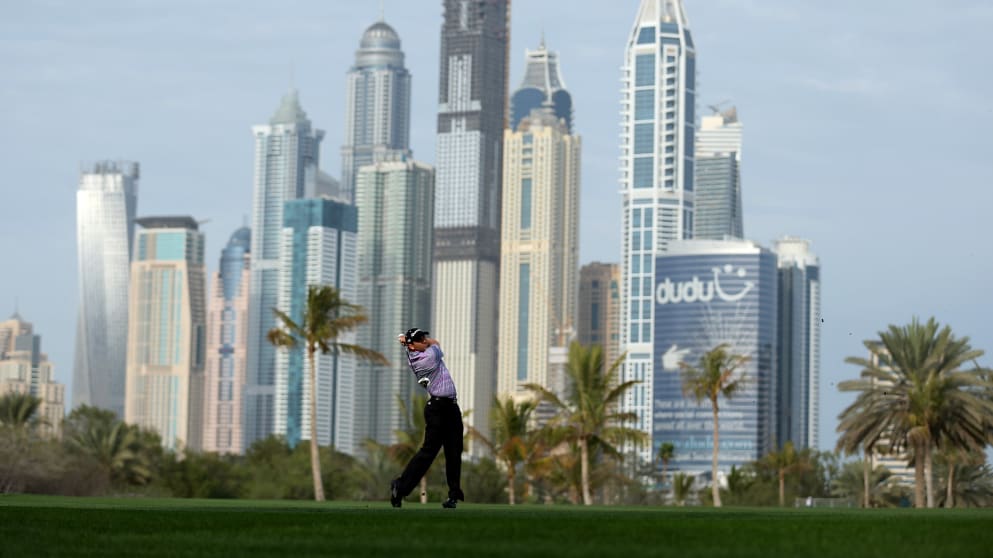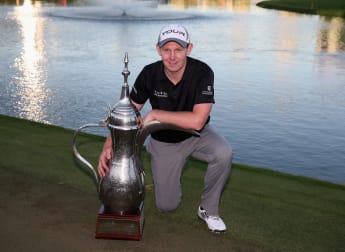Emirates Golf Club, long-time host venue to the Omega Dubai Desert Classic, this month celebrates its silver anniversary – 25 years after the inception that helped launch the growth of a Middle Eastern metropolis and a sporting super-city.

It was the vision and foresight of Sheikh Mohammed bin Rashid Al Maktoum in his dream of forging Dubai into an international destination that launched two of the city’s most well-known companies – Emirates Airlines and Emirates Golf Club – as both flourished and in turn aided the rapid development of the region.
When the club was inaugurated in 1988 it lay on the outskirts of Dubai, some seven miles from the old city centre, while today numerous towering skyscrapers provide both one of the most unique backdrops to a golf course to be found anywhere in the world and indeed a vivid testament to the city’s expansion.
The majestic Majlis Course at Emirates Golf Club is famed for having been the first all-grass golf course in the Middle East when it opened its doors and when the Dubai Desert Classic was first hosted a year later on its emerald links a precedent of sporting excellence was indubitably also set.
Nowadays, almost every sport under the sun makes a stop in Dubai at some point during the year; but if the City of Gold prospered alongside the highly regarded tournament then The European Tour’s own development was also furthered considerably, as Senior Tournament Director Mike Stewart – writing in a special commemorative edition of Emirates Golf Club Magazine – reflected.
“Up until this point in its history, The European Tour had rarely ventured outside its natural European boundaries,” writes Stewart, who has presided over every Dubai Desert Classic since its launch almost a quarter of a century ago.
“Yes, there had been brief excursions to Morocco and Tunisia, but the Middle East was a different kettle of fish altogether.
“The then Executive Director of The European Tour, Ken Schofield, realised that in order to expand and develop the Tour in the early and latter part of each year it was important to explore territories where the climate was more favourable during these months. It is fair to say that many of the committee and members of the Tour were sceptical about playing in a location about which they knew very little.
“It was a bold step to take for The European Tour but one which probably became the springboard for further ventures to destinations across the globe. Interestingly, in 2013 more than 50% of European Tour events will be held outside Europe which was probably inconceivable when the first Karl Litten Desert Classic kicked off in 1989.
“Little did I realise what sort of adventure I was about to embark upon. I was incredibly lucky to be given the opportunity to be involved in the creation of a tournament which was to become so significant, and I still have to pinch myself when I realise that we are approaching the 25th edition.”
 |
 |
|
| Emirates Golf Club in 1988 (L), a far cry from the towering metropolis it finds itself surrounded by in 2013 (R) | ||
And if Stewart has overseen both Dubai and the tournament’s rich narrative from a point of officialdom, then five-time European Tour winner Barry Lane – a veteran of all 24 previous Dubai Desert Classics – should be well-placed to reflect from a player’s point of view.
“Over the years the way it has changed is incredible,” said Lane, who came close to capturing the iconic trophy on a number of occasions. “I remember in 1989 we stayed at the airport because that was the closest hotel. It was 30 minutes from there, and there was just a two-lane road from there to the golf course.
“This place was literally in the middle of the desert. There was nothing except this oasis. It was amazing.
“You look around us now, and at pictures from the air, and it’s surrounded by buildings and hotels. It’s an incredible transformation and still a beautiful place.”
Although it is now almost two and a half decades ago, Stewart remembers the star names of European golf at that time were instantly converted as Dubai – and Emirates Golf Club – received a warm reception from the players.
He continues: “Given that it was a new event in a new territory, the field was remarkably strong in that first year. It included the likes of Colin Montgomerie, Sam Torrance, Tony Jacklin, Ian Woosnam, Jesper Parnevik, Ronan Rafferty and Vijay Singh, but ultimately it was Mark James who prevailed and became the first player to lay his hands on the iconic Arabic coffee pot.
“The first tournament had an immediate impact on The European Tour and its members, and any remaining doubters about the concept of an event in the Middle East, were quickly silenced. The Majlis course was incredibly well received and provided conditions rarely seen on The European Tour, or indeed anywhere else around the world.
“In addition, great practice facilities, a magnificent clubhouse and a perfect climate for golf made it a winning package.
“It is an event which has become as synonymous with the club as the club has with the tournament. Whilst the clubhouse has gone through a couple of internal renovations, its outward appearance remains largely unchanged and its inspired design and stunning appearance make it one of the most recognisable clubhouses in the world of golf. There is just nothing else like it.”
The oldest running tournament in the Middle East, and now the closing segment of the hugely successful Desert Swing triumvirate after the Abu Dhabi HSBC Golf Championship and the Commercial Bank Qatar Masters, the Omega Dubai Desert Classic and its home at Emirates Golf Club has undoubtedly helped to put both golf and indeed the Dubai region firmly on the map.
“Despite the dramatic changes to the Tour calendar in recent years, particularly with the emergence of other events in the Middle East, this tournament is still regarded as one of the pinnacles of the early part of The Race to Dubai on The European Tour International Schedule,” Stewart concludes. “This is due largely to a venue which has continued to move with the times and remain as relevant today as it was in the 1980s.
“My congratulations go to the respective Captains, Glynis Hendry and Moshe Kholi and all the members of the club, along with Chris May, Andrew Whitelaw and all the management and staff for reaching a significant milestone in the history of the Club. I wish them well with all the celebrations and the hope that the next 25 years can bring even greater success and recognition for what is a very special place.”





